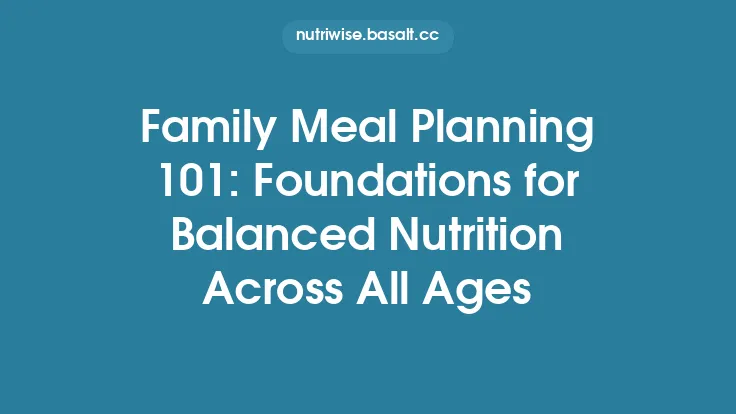Calcium is a cornerstone of skeletal health, and the most reliable way to keep your bones well‑supplied is through the foods you eat every day. While the science of calcium metabolism can be complex, the practical side of getting enough of this mineral is straightforward: plan meals that consistently feature calcium‑rich ingredients, balance them with complementary nutrients, and use cooking techniques that preserve the mineral’s integrity. Below is a comprehensive guide to building bone‑friendly menus, complete with recipe ideas, portion‑by‑portion calcium counts, and strategies for making calcium a natural part of your daily routine.
Understanding Calcium Content in Common Foods
Before you can design a calcium‑rich menu, it helps to know how much calcium typical foods provide. The values listed are approximate and based on standard serving sizes.
| Food Category | Example | Typical Serving Size | Approx. Calcium (mg) |
|---|---|---|---|
| Dairy | Low‑fat milk | 1 cup (240 ml) | 300 |
| Dairy | Yogurt (plain, low‑fat) | 1 cup | 350 |
| Dairy | Hard cheese (e.g., cheddar) | 1 oz (28 g) | 200 |
| Fortified Plant Milks | Almond, soy, oat (calcium‑fortified) | 1 cup | 300‑450 |
| Fortified Juices | Orange juice (calcium‑fortified) | 1 cup | 300 |
| Canned Fish with Bones | Sardines in oil | 3 oz (85 g) | 350 |
| Canned Fish with Bones | Salmon (with bones) | 3 oz | 180 |
| Leafy Greens (cooked) | Collard greens | ½ cup | 130 |
| Leafy Greens (cooked) | Turnip greens | ½ cup | 120 |
| Leafy Greens (raw) | Kale | 1 cup | 90 |
| Legumes | White beans | ½ cup | 100 |
| Tofu (calcium‑set) | Firm tofu | ½ cup | 250 |
| Nuts & Seeds | Almonds | ¼ cup | 95 |
| Seeds | Chia seeds | 2 Tbsp | 180 |
| Fortified Cereals | Whole‑grain breakfast cereal (calcium‑fortified) | 1 cup | 200‑300 |
| Calcium‑Rich Snacks | Cheese sticks | 1 stick (28 g) | 200 |
The Recommended Dietary Allowance (RDA) for calcium for most adults is 1,000 mg per day, rising to 1,200 mg for many women over 50 and men over 70. By selecting a mix of the foods above, you can comfortably meet or exceed this target without relying on supplements.
Principles of Calcium‑Focused Meal Planning
- Distribute Calcium Across Meals
Rather than loading all calcium into a single meal, aim for 250‑350 mg per eating occasion. This steady supply supports optimal utilization throughout the day.
- Pair Calcium with Protein
Protein enhances the anabolic environment for bone tissue. Include a quality protein source (dairy, fish, legumes, tofu) in each meal to synergize with calcium.
- Incorporate a Variety of Sources
Relying on a single food group can lead to monotony and potential nutrient gaps. Mix dairy, fortified plant milks, fish with bones, and calcium‑set tofu to diversify both flavor and micronutrient profile.
- Mind Cooking Methods
- Gentle Heat: Boiling leafy greens for a short time (2‑3 minutes) softens fibers while retaining most calcium.
- Avoid Over‑Cooking: Prolonged high heat can leach calcium into cooking water; if you do boil greens, reuse the water in soups or sauces.
- Use Bones: When cooking fish or poultry, retain the bones in stocks or sauces to extract calcium.
- Consider Portion Size
A single serving of a calcium‑dense food can be modest in volume (e.g., 1 oz cheese). Adjust portions to meet caloric needs while hitting calcium targets.
Balancing Calcium with Complementary Nutrients for Bone Health
While the focus here is on calcium, bone tissue also benefits from magnesium, phosphorus, vitamin K, and omega‑3 fatty acids. Including these nutrients in the same meals can create a more holistic bone‑supportive diet without delving into the absorption mechanisms that belong to other guides.
- Magnesium: Found in nuts, seeds, whole grains, and leafy greens.
- Phosphorus: Naturally present in dairy, fish, and meat.
- Vitamin K: Abundant in kale, broccoli, and fermented foods.
- Omega‑3s: Present in sardines, salmon, and chia seeds.
When you design a recipe, think of it as a “bone matrix” where calcium is the primary building block, and the other nutrients act as reinforcing agents.
Breakfast Ideas Packed with Calcium
1. Greek Yogurt Parfait with Berries and Chia
- Ingredients: 1 cup plain low‑fat Greek yogurt (≈300 mg Ca), ½ cup mixed berries, 2 Tbsp chia seeds (≈180 mg Ca), 1 Tbsp honey.
- Calcium Total: ~480 mg.
- Why It Works: Yogurt supplies calcium and protein; chia adds a plant‑based calcium boost and omega‑3s; berries provide antioxidants.
2. Savory Tofu Scramble with Spinach
- Ingredients: ½ cup calcium‑set firm tofu (≈250 mg Ca), 1 cup fresh spinach (≈30 mg Ca), ¼ cup diced tomatoes, 1 Tbsp olive oil, turmeric, black pepper.
- Calcium Total: ~280 mg.
- Why It Works: Tofu is a high‑calcium, high‑protein base; spinach contributes additional calcium and vitamin K.
3. Fortified Oatmeal with Almond Butter
- Ingredients: 1 cup calcium‑fortified oat milk (≈350 mg Ca), ½ cup rolled oats, 1 Tbsp almond butter (≈20 mg Ca), sliced banana.
- Calcium Total: ~370 mg.
- Why It Works: Fortified oat milk delivers a large calcium dose; almond butter adds healthy fats and a modest calcium contribution.
Lunch Options for Midday Bone Support
1. Sardine Salad Wrap
- Ingredients: 1 can sardines in oil (≈350 mg Ca), mixed greens, shredded carrots, ¼ cup diced cucumber, whole‑grain tortilla, drizzle of lemon‑yogurt dressing (½ cup yogurt = 150 mg Ca).
- Calcium Total: ~500 mg.
- Why It Works: Sardines provide calcium and omega‑3s; the yogurt dressing adds extra calcium and protein.
2. Cheddar & Apple Quinoa Bowl
- Ingredients: 1 cup cooked quinoa, ¼ cup shredded sharp cheddar (≈200 mg Ca), ½ cup diced apple, 2 Tbsp toasted pumpkin seeds (≈30 mg Ca), balsamic vinaigrette.
- Calcium Total: ~230 mg.
- Why It Works: Quinoa offers magnesium and protein; cheddar supplies a calcium punch; pumpkin seeds add magnesium and a crunchy texture.
3. Collard Green and White Bean Soup
- Ingredients: 2 cups low‑sodium vegetable broth, ½ cup cooked white beans (≈100 mg Ca), 1 cup chopped collard greens (≈130 mg Ca), 1 Tbsp olive oil, garlic, onion, herbs.
- Calcium Total: ~230 mg.
- Why It Works: The combination of beans and collard greens delivers calcium from both plant and legume sources, while the broth retains the leached minerals.
Dinner Dishes that Maximize Calcium Intake
1. Baked Salmon with Almond‑Crusted Broccoli
- Ingredients: 4 oz salmon fillet (with skin), 2 Tbsp almond meal (≈30 mg Ca), 1 cup broccoli florets (≈60 mg Ca), 1 Tbsp olive oil, lemon zest.
- Calcium Total: ~90 mg (from side) + any calcium in salmon skin (minimal). Pair with a side of fortified rice pilaf (½ cup cooked with fortified broth = ~150 mg Ca) for a total dinner calcium of ~240 mg.
2. Creamy Spinach and Feta Pasta
- Ingredients: 1 cup whole‑grain pasta, 1 cup cooked spinach (≈60 mg Ca), ¼ cup crumbled feta (≈150 mg Ca), ½ cup low‑fat milk (≈150 mg Ca), garlic, nutmeg.
- Calcium Total: ~360 mg.
- Why It Works: Milk and feta combine for a high calcium sauce; spinach adds extra calcium and vitamin K.
3. Tofu‑Stir Fry with Bok Choy and Bell Peppers
- Ingredients: ½ cup calcium‑set tofu (≈250 mg Ca), 1 cup bok choy (≈160 mg Ca), ½ cup sliced bell peppers, 2 Tbsp soy sauce, 1 Tbsp sesame oil, ginger.
- Calcium Total: ~410 mg.
- Why It Works: Bok choy is a calcium‑dense leafy green; tofu contributes a substantial calcium portion, making this a powerhouse dinner.
Snack Strategies to Keep Calcium Levels Steady
- Cheese Stick & Fruit: One low‑fat cheese stick (≈200 mg Ca) paired with a small apple.
- Almond‑Based Energy Balls: Blend ¼ cup almonds, dates, a splash of fortified almond milk, and roll into bite‑size balls (≈95 mg Ca per ¼ cup almonds).
- Yogurt Dip with Veggies: ½ cup plain low‑fat yogurt (≈150 mg Ca) mixed with herbs, served with carrot sticks and cucumber slices.
- Fortified Rice Cakes: Top a rice cake with 2 Tbsp fortified cream cheese (≈100 mg Ca) and sliced strawberries.
These snacks add 150‑300 mg calcium each, helping you bridge any gaps between meals.
Meal Prep and Batch Cooking for Consistent Calcium Supply
- Batch‑Cook Calcium‑Rich Grains
Cook a large pot of quinoa or brown rice using fortified broth. Portion into containers for quick side dishes.
- Pre‑Portion Dairy and Fortified Alternatives
Measure out servings of milk, yogurt, or fortified plant milks into individual bottles for grab‑and‑go use.
- Make a “Calcium Base” Soup
Simmer a mixture of low‑sodium broth, chopped collard greens, white beans, and a splash of fortified soy milk. Store in the fridge for up to five days; each cup provides ~150 mg calcium.
- Freeze Protein‑Rich Calcium Items
Portion sardines, salmon with bones, or tofu into freezer‑safe bags. Thaw as needed for salads or stir‑fries.
- Create a “Calcium Snack Box”
Combine cheese sticks, fortified yogurt cups, almonds, and fresh fruit in a compartmentalized container for easy access.
By front‑loading preparation, you reduce the daily decision‑making load and ensure calcium‑dense options are always within reach.
Adapting Recipes for Dietary Preferences and Restrictions
| Preference | Substitution | Calcium Impact |
|---|---|---|
| Lactose Intolerance | Use lactose‑free milk, fortified soy or oat milk, dairy‑free yogurts | Choose fortified versions to match dairy calcium levels. |
| Vegan | Replace cheese with calcium‑set tofu, fortified nutritional yeast, or almond‑based cheeses; use fortified plant milks | Aim for fortified products to meet the 300 mg per cup benchmark. |
| Low‑Sodium | Opt for low‑sodium canned fish, rinse beans, use herbs/spices instead of salty sauces | Calcium content remains unchanged; focus on flavor without added salt. |
| Gluten‑Free | Substitute wheat pasta with rice, quinoa, or gluten‑free legume pasta; ensure fortified grains are gluten‑free | No calcium loss; many gluten‑free grains are also fortified. |
| Low‑Fat | Choose low‑fat dairy or reduced‑fat cheese; incorporate calcium‑rich vegetables and fortified alternatives | Calcium remains high; fat reduction does not affect mineral content. |
When swapping ingredients, always verify the calcium content on the label, especially for fortified products, to maintain your target intake.
Practical Tips for Shopping and Storing Calcium‑Rich Ingredients
- Read Labels: Look for “calcium‑fortified” and check the milligram amount per serving. Some brands add 300 mg per cup, while others may add less.
- Buy in Bulk When Possible: Large bags of almonds, canned sardines, and fortified plant milks often have lower per‑unit costs.
- Rotate Fresh Produce: Fresh leafy greens lose calcium over time. Store them in airtight containers with a paper towel to absorb excess moisture and extend freshness.
- Freeze for Longevity: Cooked beans, tofu, and fish with bones freeze well. Portion them before freezing to avoid thaw‑and‑refreeze cycles.
- Use the “First‑In, First‑Out” Method: Place newer items behind older ones in the pantry or fridge to ensure you consume products before they approach their expiration dates.
Sample Weekly Meal Plan (≈1,000 mg Calcium per Day)
| Day | Breakfast | Lunch | Dinner | Snacks |
|---|---|---|---|---|
| Mon | Greek yogurt parfait (480 mg) | Sardine salad wrap (500 mg) | Creamy spinach & feta pasta (360 mg) | Cheese stick (200 mg) |
| Tue | Fortified oatmeal with almond butter (370 mg) | Quinoa bowl with cheddar (230 mg) | Baked salmon with almond‑crusted broccoli + fortified rice pilaf (240 mg) | Yogurt dip with veggies (150 mg) |
| Wed | Tofu scramble with spinach (280 mg) | Collard green & white bean soup (230 mg) | Tofu‑stir fry with bok choy (410 mg) | Almond energy balls (95 mg) |
| Thu | Greek yogurt parfait (480 mg) | Sardine salad wrap (500 mg) | Creamy spinach & feta pasta (360 mg) | Cheese stick (200 mg) |
| Fri | Fortified oatmeal (370 mg) | Quinoa bowl (230 mg) | Baked salmon + fortified pilaf (240 mg) | Yogurt dip (150 mg) |
| Sat | Tofu scramble (280 mg) | Collard soup (230 mg) | Tofu‑stir fry (410 mg) | Almond balls (95 mg) |
| Sun | Greek yogurt parfait (480 mg) | Sardine wrap (500 mg) | Creamy pasta (360 mg) | Cheese stick (200 mg) |
*Total daily calcium ranges from 1,050 mg to 1,250 mg, comfortably meeting adult recommendations.*
Sustaining Bone‑Friendly Nutrition Through Thoughtful Meal Planning
Integrating calcium into every meal doesn’t require exotic ingredients or complex culinary techniques. By understanding the calcium content of everyday foods, distributing that mineral across the day, and employing simple preparation strategies, you can build a diet that consistently supports bone health. The key is consistency—regularly consuming a variety of calcium‑rich foods, paired with complementary nutrients, ensures that your skeleton receives the building blocks it needs for lifelong strength. Use the recipes, tips, and sample plan above as a foundation, and feel free to adapt them to your taste preferences, cultural traditions, and dietary needs. With a little planning, calcium‑rich meals become a natural, enjoyable part of your daily routine.





